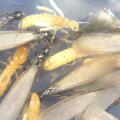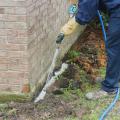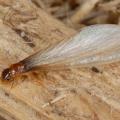Common Questions about Termites and Termite Control
- We just had termites swarm inside the house; there were hundreds of them. I sprayed them with an aerosol insecticide and they are all dead now. Does this mean we don’t have to worry about them infesting our house?
- No, it means your house has an active termite infestation and needs to be professionally treated. Contact a pest control company, tell them what you observed, and arrange for an inspection. Assuming you are sure these were termite swarmers and not ant swarmers, get the house treated even if no additional signs of termites are found during the inspection.
- How can I tell the difference between swarming termites and swarming ants?
- The short answer is that termite swarmers have straight, bead-like antennae and their front and hind wings are equal in length, while ants have elbowed antennae and their front wings are longer than their hind wings. See the section on Termites or Ants for pictures and more details. Alternatively, you can collect some, preserve them in alcohol, and mail to the Extension Insect Identification Service.
- We bought our house eight years ago. The report the realtor gave us showed that it was free of termites at the time. We don’t know if or when the previous owner had it treated and we have not had it treated since we owned it. So far we have not had any termite problems. Are we safe to keep things as they are or should we think about getting a termite treatment?
- Don’t just think about it; go ahead and get this house treated! You have been lucky so far, but it is just a matter of time before you do have an infestation.
- We bought our house a little over a year ago. The report the realtor gave us showed the house had been inspected before the sale and no termites were found, but we just found an active infestation while tearing out a wall to do some remodeling. How could this happen?
- Termite infestations are cryptic and hard to detect because they tunnel through soil and inside pieces of wood. When a termite technician does a wood destroying organism inspection on a building that is for sale, they can only inspect the areas of the building that are open and visible. They have no way of seeing termites that are tunneling under the slab, inside masonry voids, inside wooden timbers, and in other hidden areas. It is certainly important to have a wood destroying organism inspection before purchasing a building, but all the inspection can tell you is that a trained technician conducted a professional inspection of the building and did not find any termites. Because of the potential for hidden termite infestations, this should not be viewed as a guarantee the building is free of termites. This is why it is important for new homeowners to take additional steps to be sure their home is adequately protected from termites.
- Is it ok to use mulch in our flower beds? I heard mulch causes termites.
- Organic mulch, such as ground bark, pine straw, and dried leaves, is a useful gardening tool for controlling weeds, conserving moisture, and keeping flower beds looking neat. Go ahead and use it. Just be sure not to allow any type of organic mulch to be piled against the foundation of the house, especially if it becomes deep enough that it reaches the siding. This is an open invitation to termites. Better yet, try to maintain a mulch-free strip immediately adjacent to the foundation wall that is approximately two feet wide. Use gravel or other inorganic mulch in this area if you wish.
- Last week I broke open a decaying log out in the back yard and it was full of termites. It’s about 50 yards away from the house, but I wonder if we need to try to kill them in the log before they get to the house. What should we do?
- You don’t need to do anything about the termites in this log. The termites are where they should be and they are doing what they should be doing. The termites you saw in the log may represent only a portion of a much larger colony of termites and there are probably many different termite colonies on your property. It’s neither practical nor possible to try to kill all the termites in your landscape. But do let finding the termites in this log serve as a reminder to review the termite protection you have on your house. Do you have a termite contract in force on your house, or do you at least know when your house was last treated and how it was treated? If you are not sure your house is adequately protected from termites, it is time to have it treated. After all, there are a lot of termites out there in the landscape around your house, and if you don’t keep it adequately protected, some of these termites will eventually get into the house.
- I’ve read that termites will forage up to 150 feet away from their colony. If this is true, then why shouldn’t I worry about trying to kill any termites I find in stumps, logs, and other places out in the yard away from the house? Won’t they eventually find their way to the house?
- Termites are abundant throughout Mississippi woods and landscapes and they will eventually find their way into any buildings that are not properly protected. However, it is not practical or environmentally sound to try to kill all the termites in the landscape. Termite treatments should focus on protecting the building itself and on establishing a protective barrier, using either liquid termiticides or baits, in the area immediately surrounding the building.
- How much does it cost to have an average-size home treated for termites?
- Treatment cost depends on a variety of factors: size of the home; how the home is constructed—slab or crawl space; type of treatment—bait or liquid termiticide; type of contract—damage repair vs re-treat only; and many other factors. As a very rough estimate, initial treatment cost for most single-family homes will be in the range of $1,000 to $2,000 and the annual contract renewal fee will be around $200 to $300 per year.
- Which is the best method for treating an active termite infestation, termite baiting systems, or liquid termiticides?
- Baits and liquid termiticide treatments are both capable of providing long-lasting protection from termites and each method has its strengths and weaknesses. In general, bait treatments are faster and easier to install and utilize smaller quantities of insecticide, but baits are slower acting and require regular post-installation maintenance in order to remain effective. Liquid termiticide treatments require more time and effort to apply and use larger amounts of insecticide, but they provide fast-acting, long-lasting control with little or no post-treatment maintenance.
- When baits are used around a building that has an active termite infestation, it is usually necessary to spot treat the areas of the building that are infested in order to get faster control. No additional supplemental treatments are needed when installing baiting systems around buildings that are not known to be infested.
- One of the more important differences between termite baiting systems and liquid termiticides is that once a building is properly treated with a liquid termiticide, the treatment is capable of providing control for many years, even if the annual renewal fee is not paid and the termite contract is allowed to lapse after the first year or two. This is because the termiticide is still present in the soil and will continue to provide control until it degrades over time or until something occurs to disrupt the treated soil barrier. This is not true for termite baiting systems. With baiting systems, termite protection ceases once the contract is allowed to lapse because the company that installed the baiting system will no longer inspect and maintain it.
- Unless they are actively maintained, baiting systems do not provide residual control, while liquid termiticides do provide residual control.
- We had our house treated for termites three years ago and paid over $1,000 to get it done. Every year since we get a bill for around $200 for an annual contract renewal. What is this and what’s the point of paying it?
- If you have a termite baiting system type treatment, it is critical to pay the annual renewal fee every year so the company will continue to inspect and maintain the system. Allow the contract to lapse and you will no longer have termite protection.
- If you had a liquid termiticide applied a few years ago, paying the annual renewal fee keeps your termite contract in force for one more year. This usually means that the company will come inspect the building for termites once per year and if an infestation is found, they will retreat the infested area for no additional charge. (Termite contracts vary greatly; read your contract carefully for specific details.) In this case, you will usually not immediately lose all your termite protection by not paying the annual renewal fee because the liquid termiticide is probably still present in the soil. However, you will lose the annual inspection and the other protection offered in the contract.
- Eventually, the soil-applied treatment will degrade to the point where it is no longer providing effective control and you will need to have the building retreated. Without having those annual termite inspections, you may not know when this has occurred and may not realize it is time to retreat—until you discover that the building has an active termite infestation.
- Having a building properly treated for termites and keeping the contract in force by paying the annual renewal fee is the best way to keep a building constantly protected from termites.
- How long do liquid termiticide treatments last?
- This depends on the particular product used for the treatment and the rate at which it was applied. Termiticides are subjected to rigorous, long-term testing by the USDA Forest Service at four field locations in the United States. In general, products must provide 100 percent control for a minimum of 5 years in order to be labeled for use as a termiticide. Some of the better termiticide products have provided effective control for up to 12 years or longer in the USDA Forest Service trials in Mississippi. Termiticides do break down over time, and even the best termiticide cannot provide protection if the treated soil barrier around the foundation is disturbed in some way. With even the best liquid termiticides available today, it is a good idea to have buildings retreated approximately every 10 years, but this will vary depending on what product was used, as well as other factors that affect treatment efficacy.
Dr. Blake Layton, Extension Entomology Specialist
Department of Entomology, Mississippi State University
Phone: 662-325-2960
Email: blake.layton@msstate.edu
Publications
News
Mississippi’s native subterranean termites have started swarming, and these structure-destroying insects will continue to swarm across the state over the next few months.
John Riggins, professor of forest entomology in the Mississippi State University Department of Agricultural Science and Plant Protection, said termites swarm to produce new colonies when the weather warms up, often after a rain.
Termites exist all over Mississippi and will eventually infest and damage any structure that contains wood or other cellulose components unless you properly protect those structures.
Invasive Formosan subterranean termites were first found in the state 40 years ago, and soon, these dangerous pests will swarm and threaten unprotected structures in about one-third of Mississippi’s counties.
Santos Portugal, Mississippi State University Extension Service urban entomologist, said Formosan termites typically swarm in the millions from early May to early June. They have the ability to infest and significantly damage structures much more quickly than native subterranean termites.
Success Stories
A dream of the Mississippi Pest Control Association and the Mississippi State University Extension Service is coming true after more than 20 years, thanks to a generous donation by one of Mississippi’s oldest pest-control companies.





